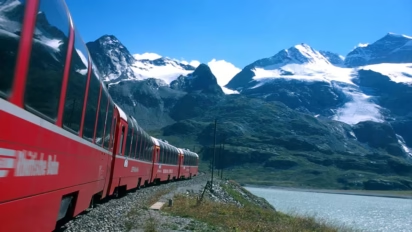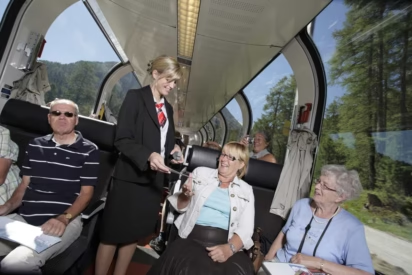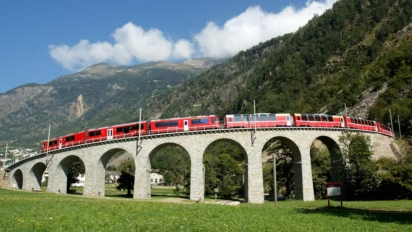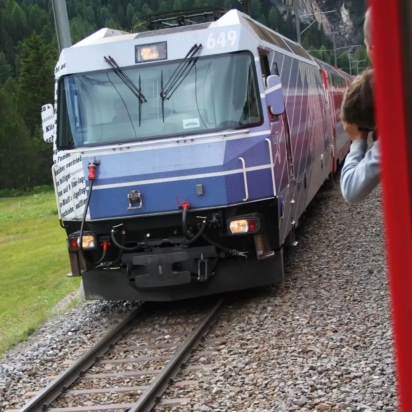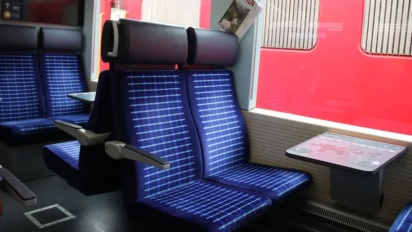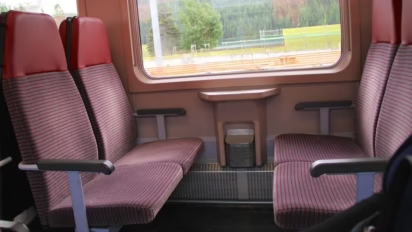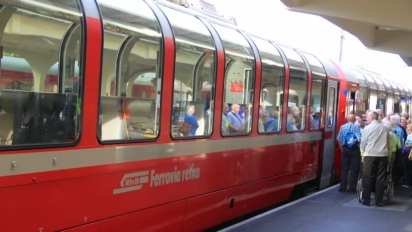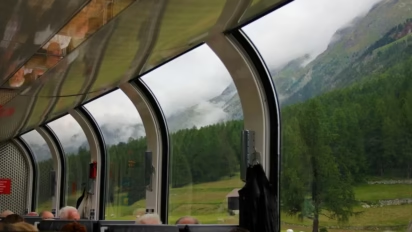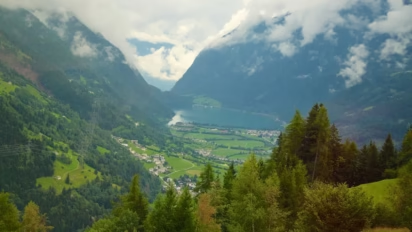Many savings options, discounted tickets, tours, and railway passes are available for traveling in the panoramic cars of the Bernina Express trains through the Alps in Switzerland.
Many savings tickets and special deals make traveling on the Bernina Express trains in Switzerland cheaper. All Swiss Railways discount cards and deals may be applied including the Swiss Pass, half-fare, and junior cards. Eurail and Interrail passes are also accepted. The Graubünden Pass gives spectacular value for holidaymakers in this lovely Alpine canton of Switzerland. The obligatory seat reservation fee is never discounted but can be avoided altogether by using regular regional trains on the same tracks. Last-minute bookings sometimes give spectacular discounts. Special day-trip tours from Milan include bus travel to and from the Bernina Express stations, while interesting tour options are often available in Switzerland.
Reservations for the Bernina Express Train Panoramic Cars in 2025
Traveling on the luxury Bernina Express trains with its huge panorama windows always requires seat reservations. This reservation fee is always charged, even for children, Swiss Pass, Junior Card, and other passes.
In 2025, the obligatory reservation scheme depends on the route. If traveling only on the stretch between St Moritz and Tirano (or v.v.) the seat reservation is CHF28 all year. If traveling the longer route between Chur and Tirano, the reservation is CHF36 from 15 May 2025 to 26 October 2025, and CHF32 for the rest of the year.
The reservation fees for Bernina Express seats are the same whether traveling first or second class.
The reservation fee is per seat, per train. Any interruption of the journey requires a second reservation if another Bernina Express train is used. Similarly, a separate reservation is needed for traveling on the Bernina Express Bus between Tirano and Lugano.
In 2025, the reservation fees for the Bernina Express bus are CHF14 (CHF16 in the high season).
Reservations may be made up to minutes before the actual departure or well in advance. It is easily done online at Rhaetian Railways, where the exact seat may be selected from the diagram. Note that the direction of travel of the train is not guaranteed, although the first-class wagons are usually at the front.
The seat reservation and ticket purchase for the Bernina Express are two separate transactions. Reserve in advance to guarantee a seat, but if the weather turns out absolutely miserable, simply don’t buy a ticket for travel. (The reservation fee is of course lost forever.)
Sample Fares on the Bernina Express Panoramic Trains

The price of tickets for traveling on the Bernina Express trains is the same as for traveling on regular regional trains using the same tracks. Sometimes the Bernina Express panoramic cars are even attached to the rear of a regular train. The only price difference is the obligatory reservation fee for the Bernina Express.
Sample fares without the reservation fee for the Bernina Express in second class (first class) in 2025 are:
- Chur to Tirano – CHF66 (CHF113)
- St Moritz to Tirano – CHF33 (CHF57)
- Tirano to Lugano by bus – CHF41
Travel to Poschiavo is around CHF8 (CHF12) cheaper.
The Bernina Express Bus from Tirano to Lugano is CHF41 plus the reservation fee.
A return ticket is simply double the single fare and thus gives no savings.
Dogs may be taken on the Bernina Express. Small dogs travel free in a transport container or basket. For larger dogs, buy a half-price ticket adult ticket for second class (even if traveling first class). A dog day ticket may in some instances be cheaper at CHF25. (If a ticket requires a name, use “dog” or “Hund” and not the name of the dog!)
Bicycles are not allowed on the Bernina Express — use the alternative regional express trains.
Savings Fares and Discount Tickets for the Bernina Express Train

Although the Rhätische Bahn is a separate company from Swiss Railways, all regular Swiss Railways discounts and savings passes may be used. The half-fare card, which cuts virtually all public transportation fees in Switzerland in half, is often the most useful. Special short-term, one-month, international half-fare cards are available for non-Swiss residents. Eurail and Interrail passes, and of course Swiss Travel Passes, are accepted and are great value for traveling in Switzerland.

Two special regional travel passes are only valid on public transportation in Graubünden:
- UNESCO Welterbe Pass – unrestricted travel on two days (within four) on trains on the UNESCO World Cultural Heritage listed railway line between Thusis and Tirano, excluding travel on the Bernina and Glacier Express trains. However, it may be used on the regular hourly trains on the same route.
- Graubünden Pass – valid for 2 days (within 7) or 5 days (within 14) – this pass covers almost all trains and buses within the canton Graubünden (or in a cheaper version for smaller regions).
The Rhaetian Railways sometimes have special deals for travel on the Bernina Express (and other trains in Graubünden) making it worth a peek at its website before booking. In 2025, a special last-minute deal allows for return travel in second class from Chur or St Moritz to Tirano for CHF99 or Chur to Tirano return for CHF109 including the reservation fee in both directions. Last-minute in this case is an online booking within six days of travel.
Save on Bernina Express Train Tickets with Day-Trip Tours and Group Bookings
Day-trip tours, especially from Milan but also from other destinations in both Switzerland and Italy, may offer good deals and include transportation to and from the Bernina Express departure and destination stations.
Swiss Railways also often have RailAway package deals with discount combination sightseeing admission or event tickets that may offer further savings on train travel. Many travel agents offer package deals combining Swiss train travel with hotel reservations in package deals, which can offer considerable savings over separate bookings. In the off-season, free upgrades to first-class travel are often available in such package deals.
Swiss railway passes and train tickets are sold in the USA and internationally by RailEurope or the easy-to-use Trainline. Exchange rates and foreign credit card charges can sometimes make a difference in prices. Both the Eurail and Interrail passes are valid on the Bernina Express.
Children Travel (Almost) for Free on Swiss Trains
For travelers with children 6 to 16, the Junior Card is often the best public transportation deal in Switzerland. It cost CHF30 per year but allows the child to travel for free when a parent (very broadly defined) has a valid ticket. It pays for itself on a Chur to Tirano journey.
The Junior Card may be added for free to almost any international Swiss Railways travel card, in which case it is referred to as a family card. However, the child’s name must be added at the time of purchase – it cannot be added at a later stage.
Children under 6 travel for free on public transportation in Switzerland
The obligatory reservation fee for the Bernina Express and other trains or buses is not discounted for children.
Cheaper Regular Regional Trains on the Bernina and Albula Lines
Regular regional trains of the Rhätische Bahn operate on the same tracks and with higher frequency than the luxury Bernina Express trains.
The fares and tickets for regular regional trains on the same routes as the Bernina Express trains are the same, except for saving the reservation fee. Regional trains stop more frequently – allowing sightseeing at more sites – but are hardly slower than the Bernina Express. On longer journeys train changes may be required on regional trains but even these barely add to the overall traveling time.
A good option, when planning sightseeing along a return journey, is to enjoy the convenience of the direct Bernina Express one way and to return with sightseeing stops en route on the regional trains.
The express in “Bernina Express” indicates that the train does not stop very frequently. Its actual speed is no faster (or slower) than regular trains using the same tracks.
Regional trains in Switzerland are generally very comfortable too. The exact train and seats will be known only when boarding the train. Many travelers find the seats in the older wagons more comfortable. In contrast to the always air-conditioned panoramic cars of the Bernina Express, some regional trains only have heating but windows can be opened for great views and non-glare photos too.
First vs Standard Second Class Tickets on Swiss Trains?
Is First Class worth it on the Bernina Express and Swiss Railways trains? First-class tickets are almost twice the price of second class but some may find the spacious seats and fewer passengers worth the splurge. (However, first-class seats often sell out and are particularly popular with rail pass travelers.)
On the Bernina Express panoramic window cars, seats in second class are comfortable and usually spaced two on each side of the aisle, often making seating for a group of four. First-class seats are a bit wider with two seats on one side and only a single seat across the aisle.
Best Seats and Direction of Travel on the Bernina Express Trains
A few points to keep in mind when picking seats:
- The reservation map will indicate the exact position and grouping of seats.
- Being in the first or last wagon of the train gives the best views of the train on sharp turns and switchbacks.
- Trains generally maintain the direction of travel for the entire journey.
- The direction of travel of the train is not guaranteed. The first-class wagons are usually at the front but may end up at the rear on the day of travel.
Traveling from north to south is probably a bit more interesting, as the view looking down from the Alps when coming over the Bernina Pass and around Alp Grüm is nothing short of spectacular. Going up the mountain of course improves the view constantly too but the surprise element of suddenly looking down the valley is missed when traveling northwards.
In winter, the final travel may be in the dark on the northbound trains, which truly ruins the views.
Food and Drink on the Bernina Express Trains
The Bernina Express trains do not have a restaurant car or at-seat restaurant service as on the Glacier Express. A trolley with coffee and snacks usually operates on the train but it may take hours before it comes by.
Bringing a picnic and own drinks is a cheaper (and generally much better tasting) option. Swiss Railways coffee is surprisingly good but comes at a price.
More on Panoramic Train Journeys in Switzerland
- Best Luxury Panorama Express Trains in Switzerland
- Travel on the Glacier Express for more details on the slowest express train in the world.
- Saving Tips for Traveling on the Glacier Express Trains — book early.
- Travel on the Bernina Express – from the glaciers of Graubünden to the palm trees of Italy and Lugano.
- Savings Tips for Traveling on the Bernina Express Train
- Jungfraujoch – Top of Europe — Highest train station in the Alps. Now also partly possible by Eiger Express cable car.
- Golden Pass Trains from Montreux via Interlaken to Lucern. Luxury Golden Pass Express trains require no reservation surcharge.
- Buy train tickets through Rail Europe or easy-to-use Trainline.
- Eurail, Interrail, and Swiss Travel passes are valid on the Glacier and Bernina Express trains obligatory seat reservations are extra.
- Book tours and combination deals on the Bernina Express.

